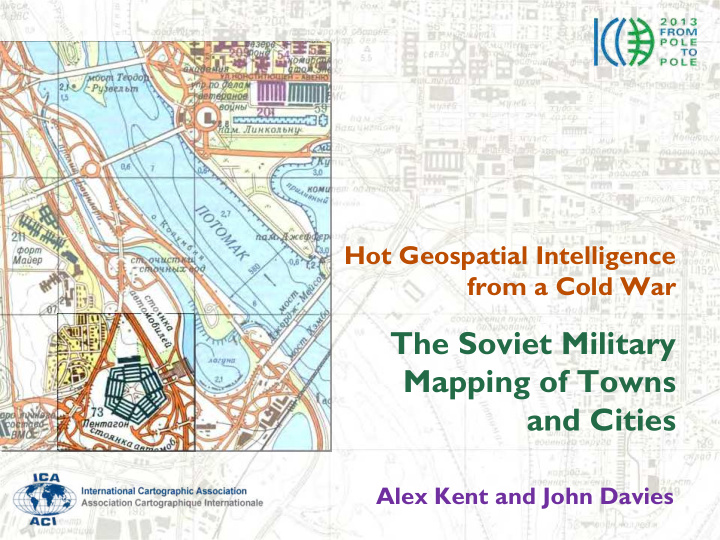



Hot Geospatial Intelligence from a Cold War The Soviet Military Mapping of Towns and Cities Alex Kent and John Davies
Context • Produced by the VTU (military topographic directorate of the Soviet Union) from WWII onwards, in parallel with the Soviet military topographic map series at six scales (from 1:25,000 to 1:1,000,000) • Became available in the West, via Latvia , at ICC Köln, 1993 • Over 2,000 cities in 130 countries mapped at scales from 1:5,000 to 1:25,000 (mostly 1:10,000 or 1:25,000) • Standard projection , ellipsoid , datum and symbology , and usually printed on sheets larger than A0
• At least 91 towns and cities mapped, at least once, from 1950 on • Three scales (1:5,000, 1:10,000 and 1:25,000)
Blackburn, 1974 (1 sheet, 1:10,000)
London, 1985 (4 sheets, 1:25,000)
Belfast, 1964 (1 sheet, 1:10,000)
Dover, 1940 (German Planheft , 1:10,000) Dover, 1974 (VTU, 1:10,000)
Pembroke, 1953 (OS, 1:10,560) Pembroke, 1950 (VTU, 1:10,000)
Observations • Comprehensive topographic detail, with strategic buildings/objects delineated , identified and classified • Production quality is consistently high • Local maps and directories used less, with greater reliance on satellite imagery (e.g. Zenit program of ‘cartographic’ satellites) from the early 1970s • Some data also gathered by field observation (e.g. the clearance height under bridges over rivers)
Cairo, 1972 (4 sheets, 1:25,000)
Washington, D.C., 1975 (4 sheets,
San Diego, 1980 (4 sheets, 1:25,000)
Port ‐ au ‐ Prince, 1983 (1 sheet, 1:10,000)
Mecca, 1980 (2 sheets, 1:10,000)
Sydney, 1984 (4 sheets, 1:25,000)
Chatham, 1984 (2 sheets, 1:10,000)
San Francisco, 1980 (8 sheets, 1:25,000)
Halifax, 1975 (1 sheet, 1:10,000)
Halifax, 1989 (1 sheet, 1:10,000)
Maribor, 1975 (1 sheet, 1:10,000) VTU City Plan
Maribor, 1993 (1 sheet, 1:20,000) NIMA City Graphic
Some Avenues for Future Research • How accurate are the plans, in terms of both spatial positioning and completeness/classification? • How do the Soviet plans compare with contemporary military plans produced by other countries? • Can the design of the Soviet plans provide useful lessons when creating new maps, particularly in presenting a high amount of geographical information?
Thank you! Kent, A.J. and Davies, J.M. (2013) “Hot geospatial intelligence from a Cold War: The Soviet military mapping of towns and cities” CaGIS 40 (3) pp.248-253. alexander.kent@canterbury.ac.uk john@jomidav.com
Recommend
More recommend